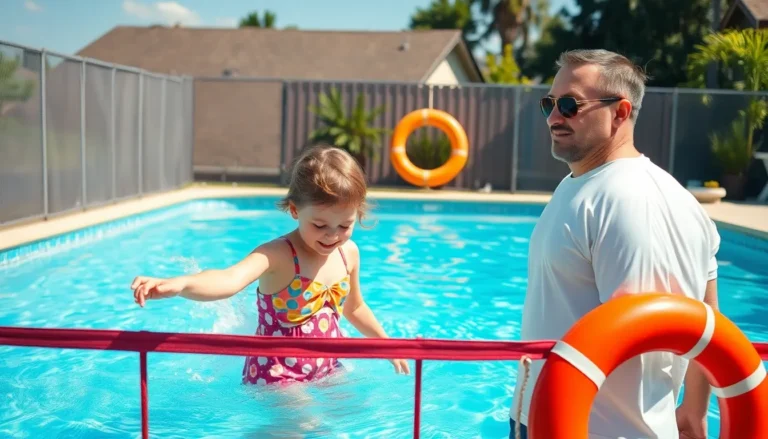Table of Contents
ToggleMoving into a new rental can feel like a thrilling adventure—like jumping out of a plane with a parachute that may or may not be packed correctly. To ensure a smooth landing, having a rental move-in checklist is absolutely essential. It’s the secret sauce that transforms chaos into calm, allowing newcomers to focus on turning their new space into a cozy haven instead of a cardboard box jungle.
Imagine walking into your new home armed with a list that covers everything from checking for leaky faucets to figuring out how many pizza boxes it takes to fill your living room. This checklist isn’t just a tool; it’s your trusty sidekick in the epic quest of settling in. So grab your pen and get ready to tackle the to-dos that’ll make your move feel less like a circus act and more like a well-orchestrated symphony.
Importance Of A Rental Move-In Checklist
A rental move-in checklist plays a crucial role in facilitating a smooth transition to a new home. Newcomers can avoid issues by methodically addressing maintenance concerns and organizing their belongings. This checklist acts as a roadmap, ensuring essential tasks are completed efficiently.
Checking for potential maintenance issues helps tenants identify problems before settling in. Landlords appreciate proactive communication about repairs, which enhances tenant relationships. Creating an organized plan allows moves to proceed with minimal stress, transforming an overwhelming process into a manageable one.
It’s important to inventory belongings, as listing items can prevent loss or damage claims later. Documenting the condition of the space at move-in also protects tenants from unfair charges upon vacating. By prioritizing essential tasks, individuals enhance their overall moving experience, limiting chaos in their new space.
Ensuring that utilities are functioning before the first night’s stay contributes significantly to comfort. This checklist fosters awareness of important deadlines, such as lease agreements or rental payments. Utilizing this tool enables newcomers to focus on personalizing their new environment rather than getting lost in logistics.
Employing a rental move-in checklist establishes a sense of preparedness and calm. This organizational tool ultimately leads to an enjoyable settling-in period, setting a positive tone for the new living arrangement.
Key Components Of A Rental Move-In Checklist

A comprehensive rental move-in checklist includes vital components that streamline the transition process. Focus on these key areas to ensure a successful start in a new home.
Documentation And Agreements
Verify all lease agreements before moving in. Ensure the lease terms are clear and understood, including rent payment dates and policies. Request copies of essential documents, such as the pet policy and utility arrangements. Check for any additional fees that may apply throughout the rental period. Having all documentation organized promotes transparency and eases future communications with the landlord.
Inventory Of Items
Create a detailed inventory of personal belongings before packing. List items in specific categories, such as furniture, appliances, and personal effects. Take photographs of valuable items for reference during insurance claims. This inventory serves both practical and protective purposes, helping to prevent disputes regarding lost or damaged items. Updating the list during the move-in process ensures accuracy and accountability.
Condition Assessment
Conduct a thorough condition assessment of the rental property upon arrival. Inspect each room for damages, such as stains, scratches, or broken fixtures. Document existing issues with time-stamped photographs and written descriptions to provide evidence to the landlord. Communicating problems immediately helps avoid disputes when vacating the unit. Keeping a record of the property’s condition fosters trust between tenants and landlords.
Tips For Using The Rental Move-In Checklist
Using a rental move-in checklist enhances the moving experience significantly. It helps streamline the process and ensures nothing gets overlooked.
Timing Your Checklist
Utilizing the checklist early makes a noticeable difference. Complete tasks before moving day to avoid last-minute chaos. Some steps warrant attention as soon as the lease is signed. Verifying utilities and scheduling move-in dates need timely action. Areas needing inspection or repair deserve priority, so addressing them upfront prevents future discomfort. Allocate specific days for each item to ensure thorough completion without rushing.
Collaborating With Your Landlord
Open communication with the landlord sets a positive tone. Discuss concerns or special requests based on the checklist items. Arrange property walkthroughs together to identify existing damages that require documentation. This collaboration fosters a stronger relationship and clarifies property conditions upfront. Maintain records of all conversations regarding maintenance or repairs to uphold transparency. Tenant and landlord cooperation leads to smoother interactions throughout the rental period.
Common Mistakes To Avoid
Failing to document the condition of the rental property can lead to disputes later. Inspection reports, photos, and written descriptions of any pre-existing damages create a clear record. Skipping this step often results in unfair charges when vacating.
Neglecting to verify utility connections is a common oversight. Ensuring that electricity, water, and gas are active before moving in contributes to immediate comfort. Confirming these services can prevent uncomfortable first nights.
Ignoring lease terms often creates confusion. It’s essential to read the lease carefully for clauses on maintenance responsibilities, late fees, and property rules. Misunderstandings arise easily without this clarity.
Postponing a walkthrough with the landlord can hinder communication. Scheduling this meeting before moving in allows tenants to address concerns about the property directly. Engaging in this process fosters a productive relationship.
Overlooking deadlines for rental payments leads to financial stress. Being aware of when rent is due helps avoid penalties. Noting these dates on a calendar or planning app aids in timely payments.
Assuming everything is in good condition without thorough checks is risky. Conducting a detailed inspection of appliances, plumbing, and heating systems saves tenants from unexpected issues. Discovering the state of these utilities upon arrival can significantly reduce stress.
Lastly, not keeping a copy of the move-in checklist can cause confusion. Hanging onto this document allows for easy reference regarding tasks and responsibilities. Staying organized minimizes the potential for errors and miscommunication throughout the rental period.
A rental move-in checklist is more than just a list of tasks; it’s a vital tool that paves the way for a successful transition into a new home. By following this structured approach, individuals can navigate the complexities of moving with confidence and ease.
Proactive communication with landlords and thorough documentation of the property condition not only protect tenants but also foster positive relationships. As newcomers settle in, they can focus on creating a welcoming environment, knowing they’ve taken the necessary steps to ensure a smooth move. Embracing the process with an organized mindset ultimately leads to a more enjoyable and stress-free experience in their new living space.







